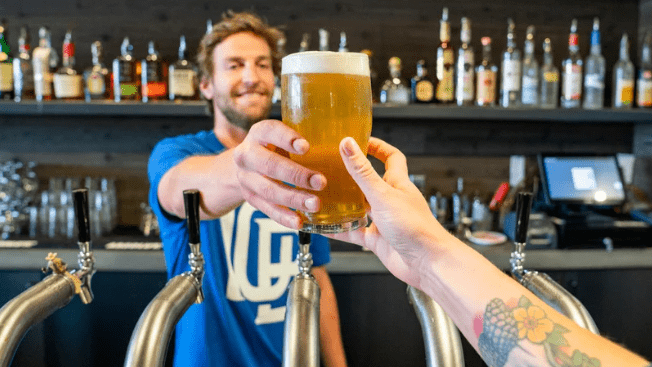Mixing Adderall and alcohol creates serious health risks that many people underestimate. More than 60% of nonmedical users of prescription stimulants report combining them with alcohol, despite dangerous cardiovascular and behavioral consequences.
This article explains the specific risks, side effects, and interactions you need to know to protect your health.
Understanding the Adderall Alcohol Interaction
When you combine Adderall with alcohol, you create a dangerous pharmacological conflict.
Adderall is a central nervous system stimulant that increases heart rate, blood pressure, and alertness by boosting dopamine and norepinephrine levels. Alcohol acts as a depressant, impairing judgment and motor coordination.
The most dangerous aspect of this combination is how stimulants mask alcohol’s sedative effects. This masking leads people to drink more than they normally would, reaching higher blood alcohol concentrations without feeling intoxicated.
College studies show that concurrent stimulant and alcohol use increases wakefulness while hiding alcohol’s warning signs.
Cardiovascular Strain
Both substances stress your cardiovascular system in different ways. Adderall increases your heart’s oxygen demand through elevated heart rate and blood pressure.
Alcohol can trigger irregular heart rhythms, especially during binge drinking episodes. Together, they create a perfect storm for cardiac complications.
Short-Term Risks and Side Effects
Even a single night of mixing Adderall and alcohol can cause serious health problems. These immediate effects often put the heart and nervous system under extreme stress.
Immediate Cardiovascular Dangers
The combination puts enormous strain on your heart and blood vessels. Emergency department data reveals that alcohol is present in 16.1% of amphetamine-related emergency visits.
Case reports document myocardial infarction in young people after mixing Adderall with alcohol, highlighting how even healthy individuals face serious risks.
- Dangerous blood pressure spikes
- Irregular heart rhythms
- Chest pain and palpitations
- Risk of heart attack, even in young adults
Behavioral and Neurological Effects
Mixing these substances impairs your ability to make safe decisions. The stimulant effect masks how intoxicated you actually are, leading to:
- Increased risk-taking behaviors
- Impaired driving ability despite feeling alert
- Higher likelihood of accidents and injuries
- Severe agitation or anxiety attacks
Overdose Risk
Because Adderall masks alcohol’s sedative effects, you may continue drinking to dangerous levels. This significantly increases your risk of alcohol poisoning. National surveillance data shows that single-substance exposure represents the minority of stimulant-related emergency visits, with alcohol being a leading co-intoxicant.

Long-Term Health Consequences
Beyond the initial dangers, repeated use can leave lasting damage. Over time, the body struggles to recover from the constant push-and-pull of stimulants and alcohol.
Cardiovascular Complications
Repeated episodes of mixing Adderall and alcohol may contribute to lasting heart problems. The constant stress on your cardiovascular system can lead to:
- Sustained high blood pressure
- Increased risk of future heart rhythm problems
- Accelerated heart disease in vulnerable individuals
- Greater likelihood of stroke
Substance Use Disorders
Research shows that nonmedical stimulant users face nearly three times higher risk of developing substance use disorders.
The combination creates a dangerous cycle where each substance seems to enhance the other’s effects, making it harder to stop using either one.
Academic and Social Problems
Despite beliefs that stimulants improve performance, studies consistently show the opposite. Students who mix Adderall with alcohol experience:
- Lower grade point averages
- More missed classes
- Increased likelihood of academic probation
- Damaged relationships and social consequences
Who Faces the Greatest Risk?
Not everyone is affected the same way. Certain groups face much higher chances of harm due to lifestyle, underlying health, or environment.
College Students and Young Adults
Young adults represent the highest-risk population for this dangerous combination. Campus studies reveal that 19% to 36% of students who use prescription stimulants nonmedically also drink alcohol simultaneously.
This pattern is especially common in competitive university environments and Greek life settings.
People with Heart Conditions
Anyone with existing cardiovascular problems faces amplified risks. Even minor heart rhythm irregularities or high blood pressure can become life-threatening when combined with the stress of mixing stimulants and alcohol.
Those Using Unregulated Sources
The CDC warns that disrupted access to prescription stimulants may push people toward illegal markets where counterfeit pills containing fentanyl pose additional overdose risks. Adding alcohol to this scenario creates an extremely dangerous situation.
Emergency Warning Signs
In some situations, the effects of mixing can quickly turn life-threatening. Knowing the red flags can make the difference between early intervention and tragedy.
- Seek immediate medical attention if you or someone else experiences:
- Chest pain or severe heart palpitations
- Difficulty breathing or shortness of breath
- Fainting or loss of consciousness
- Severe confusion or agitation
- Signs of alcohol poisoning despite feeling alert
These symptoms can indicate serious cardiovascular events or dangerous intoxication levels that require emergency treatment.

Safe Alternatives and Prevention
While the risks are serious, there are safer approaches. Understanding prevention strategies can help people avoid dangerous outcomes altogether.
Complete Avoidance
The safest approach is never mixing Adderall with alcohol. If you’re prescribed Adderall, avoid drinking alcohol entirely on days when you take your medication. The stimulant doesn’t make drinking safer; it makes it more dangerous by hiding your level of impairment.
Treatment Considerations
Healthcare providers should screen all stimulant users for alcohol consumption patterns. When active alcohol misuse is present, clinical guidelines suggest considering non-stimulant ADHD medications like atomoxetine until sobriety is established.
Campus and Community Prevention
Educational programs must address the specific risks of simultaneous use rather than treating alcohol and stimulant misuse as separate issues. Prevention efforts should target high-risk environments where mixing is most common.
Why Does This Matter for Your Health?
The evidence is clear: mixing Adderall and alcohol substantially increases your risk of serious health complications.
Emergency department trends show a fourfold increase in stimulant-related visits among young adults, with alcohol frequently involved in the most severe cases.
This isn’t just about avoiding a bad night. The combination can trigger heart attacks in healthy young people, lead to alcohol poisoning despite feeling alert, and set the stage for long-term substance abuse problems.
The masked intoxication effect means you can’t rely on normal warning signs to keep you safe.
Understanding these risks empowers you to make informed decisions about your health. Whether you’re taking Adderall as prescribed or someone you care about is struggling with substance use, recognizing the serious dangers of this combination could prevent a medical emergency or save a life.
If you’re struggling with substance use involving prescription stimulants and alcohol, professional help is available.
Recovery programs that understand the complexities of polysubstance use can provide the support and treatment you need to regain control of your health and life. Consider reaching out to our addiction treatment specialists who can help you develop a safe, effective recovery plan.

 info@handinhandrecovery.com
info@handinhandrecovery.com 3411 Austell Road Suite 200, Marietta, Georgia, United States
3411 Austell Road Suite 200, Marietta, Georgia, United States

